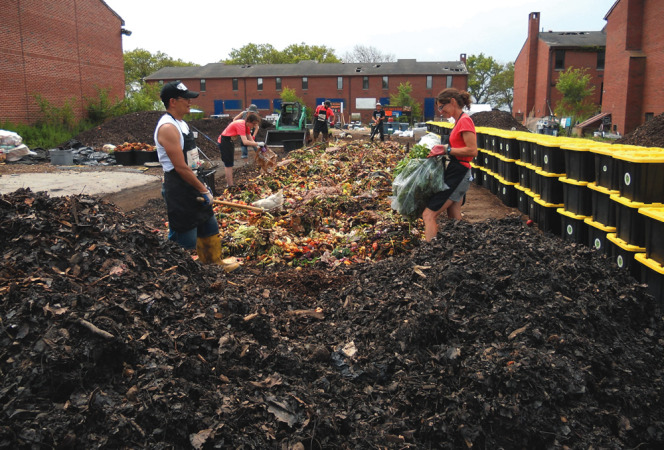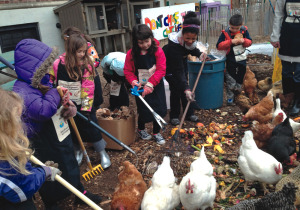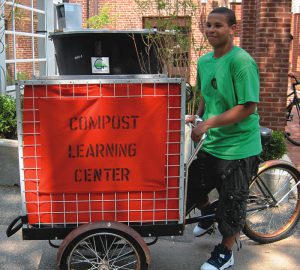Earth Matter NY, located on Governors Island in New York Harbor, operates a Compost Learning Center, training programs, zero waste initiatives and a community composting site. Part V
BioCycle October 2014
This article series focuses on the past, present and future of urban community composting of food scraps and other organics diversion in New York City. The series is being written in collaboration with the New York City Department of Sanitation’s Bureau of Waste Prevention, Reuse and Recycling, as well as sister agencies.
Earth Matter NY, Inc., based on Governors Island in New York City, was founded in 2009 by Marisa DeDominicis, Charlie Bayrer and Kendall Morrison. Throughout the 2000s, Earth Matter’s founders became very involved in composting initiatives at community gardens, in part to help manage food scraps dropped off by residents. They collaborated on a number of projects, including helping to manage food scraps dropped off at the Fort Greene Greenmarket. In 2009, Morrison met an organizer for City of Water Day on Governors Island, who asked if Earth Matter would be interested in providing source separation and composting services for the event. The organization successfully provided the services, which led to Earth Matter requesting a partnership permit that enabled it to establish its home on Governors Island.
As part of BioCycle’s series on community composting in New York City, we sat down with two of Earth Matter NY’s cofounders, Marisa DeDominicis and Charlie Bayrer, to learn about the founding of their organization and their work to build a zero waste community.

Volunteers assist with mixing foods scraps from New York City’s Greenmarkets with an equal amount of preblended carbon amendment to create an aerated static pile. Earth Matter NY cofounder Marisa DeDominicis in on right. Photo courtesy of Earth Matter NY
BioCycle: What is Earth Matter NY?
DeDominicis: Earth Matter NY, Inc. is a nonprofit organization dedicated to advancing the art, science and application of composting in and around New York City. We are based on Governors Island, a 172-acre island in the heart of New York Harbor, and only 800 yards from Lower Manhattan. Our work is focused on four primary areas: Compost Learning Center, training programs for youth and adults, zero waste initiatives, and a composting operation.
BioCycle: Why did you choose Governors Island as Earth Matter NY’s home base?
DeDominicis: It was the request for us to provide source separation and composting services for the City of Water Day event on Governors Island that truly formalized our organization. We recruited 24 volunteers, built source separation stations, and installed a composting system on the Island so that we could compost on site. That was our first event collection and processing experience. The public responded really well to our presence. Through this event, we realized that Governors Island could be our new home. So we immediately began pursuing the Trust for Governors Island (TGI), the organization responsible for the operations, planning and redevelopment of 150 acres of the Island, to secure space to do our work. Ultimately, TGI granted us a partnership permit, which provided Earth Matter with free space as long as we provided free public programming for the 2010 season. We have had a permit ever since.
BioCycle: What has been Earth Matter’s role in helping the Trust for Governors Island transform the Island into a public destination and recreation space?
Bayrer: During the island’s public season, which runs from May to September, hundreds of thousands of visitors explore its new park and participate in events. Aside from seeing the great potential of Governors Island as a high profile educational opportunity, we also recognized its potential for an easily quantifiable, measurable composting pilot. We have the opportunity to help build a community that is as close to zero waste as possible. We are aiming to do that by shifting the culture through fun and engaging public education programs. Additionally, as much of the development on Governors Island is happening right now, we have the opportunity to develop and put infrastructure in place before the development really occurs.
BioCycle: What is the volume of organics managed by Earth Matter NY on Governors Island?
Bayrer: Over the past 12 months, with support from the NYC Department of Sanitation (DSNY), Earth Matter NY has accepted and composted 567,464 pounds of organics on Governors Island. That material comes from four primary sources. The first is GrowNYC’s residential food waste drop-off program at Greenmarkets, which accounts for slightly less than 50 percent of our intake. All of that material is generated off-island, and is transported to us in batches on a weekly basis. The second source is leaf and yard waste from Governors Island. Currently, the Island generates 300 cubic yards (cy) of leaves annually, and we are on target to manage all of that material. The TGI has put in 26 acres of new parkland and several thousand new trees, but the trees are quite young so the amount of leaf waste will grow over time. The other two sources of material are our 14 source separation stations and vendors on Governors Island. These sources generate relatively low amounts of organics, but are increasing steadily. Earth Matter NY services the stations and vendors daily throughout the public season on Governors Island.
BioCycle: Please describe your composting operation on the island.
Bayrer: About 10 percent of the organics we receive are composted in our “compost promenade” of backyard and small-scale compost devices as part of our Learning Center’s activities. The other 90 percent of the organics we receive are composted in an aerated static pile (ASP) system based on O2 Compost designs. We use a Jay Lor Mini-Mixer to mix and break up the material and a Bobcat S175 skid steer loader with a snow bucket attachment to turn and move piles.
We also have a Wallenstein Wood Chipper that we initially thought would be the go-to machine for shredding compostable serviceware. We had previously discovered that shredding compostable serviceware, particularly flatware, would ensure rapid breakdown in our piles, and chose the Wallenstein because it had a 10-inch by 10-inch throat opening. We found, however, that this was still a labor-intensive process. The machine is great for yard waste, but not for serviceware. We tried using the Jay Lor with the simple intent of better integrating compostable serviceware into the mix by blending it with a bulking agent before blending it with food scraps. Unexpectedly, what we found is that the Jay Lor, even though it’s not a grinder, does break up the material sufficiently for efficient breakdown.

The Compost Learning Center is home to chickens and goats, which not only feed on food scraps but help attract visitors to Governors Island into the Center to learn about composting. Visitors include school groups. Photo courtesy of Earth Matter NY
BioCycle: Through our interviews with NYC’s larger community composting sites, including BIG!Compost and the Lower East Side Ecology Center, we’ve noticed a similar challenge of identifying and adapting technology to fit the needs of a newly-emerging scale of composting. What has been Earth Matter NY’s experience with this evolution?
Bayrer: It has been enormously helpful to be a part of this larger community of composters in NYC, and to be growing and evolving alongside one another. BIG!Compost was the first site, for example, to install an aerated static pile, under Peter Moon of O2 Compost’s guidance. It developed an extended ASP, which reduced the need for turning. However, the site did not have machinery when it first started using the ASP, so each time fresh material was incorporated or compost was harvested, it was significantly more labor intensive than the smaller windrow method used at Red Hook Community Farm and the Compost Learning Center. Using the knowledge gained from BIG!Compost, we knew we had to initially adapt the ASP process to better fit human [labor] capacity.
DeDominicis: Although our operation has grown significantly, and we now use machinery like the Jay Lor and Bobcat, it is very important to us that we retain an engaging and community-driven personality as an organization. So, for example, we name our compost piles. It’s something we picked up from Karl Hammer of Vermont Compost. We just named the last one “Jazzy” because much of the compostable serviceware incorporated into the pile came from the Jazz Age Lawn Party event on Governors Island. Naming the piles creates a sense of ownership for the people who participate in our community builds, during which we process 11,000 pounds or more of food scraps from the GrowNYC Greenmarkets. The volunteers know which pile they made and feel a stronger connection to their work.
BioCycle: Can you tell us more about Earth Matter NY’s Compost Learning Center?
DeDominicis: Our Compost Learning Center, which is open to the public Saturday and Sunday throughout the summer, is home to a variety of composting systems and devices. Visitors are welcome to participate in activities involving everything from worm bins to windrows. This is why we call it a ‘learning center,’ as opposed to a demonstration site or education center. We want to encourage hands-on experimentation and exploration of composting. Perhaps most importantly, we want to learn from the people who visit. Every day we are learning alongside our visitors about how the composting process can become accessible for all New Yorkers, and how people can go on to become leaders in their own communities.
Bayrer: The Compost Learning Center is also home to our chickens and goats, which serve several important functions. First, they get people in the door. People who are new to composting don’t notice our piles of ‘brown stuff,’ no matter how big they are, but they are drawn to chickens. Then, once we’ve gotten them through the door, visitors can learn a lot about the nutrient cycle from the animals. We provide the chickens and goats with food scraps, and they give us the manure. Lastly, our chickens give us eggs, which are a great reward for our volunteers.
BioCycle: Does Earth Matter NY offer organized training programs at the Compost Learning Center?
DeDominicis: In addition to its use as a public engagement site, the Compost Learning Center is also a training center for our Adult Apprenticeship Program and Youth Internship Program. Over the past 12 months, we have trained 26 apprentices and interns. The training piece is really critical for us. We want people to learn about composting by doing it, and we want to see as many hands in the process as possible.

Earth Matter NY collects food scraps from the public sorting stations and vendors on Governors Island using a tricycle modified for that purpose. Photos courtesy of Earth Matter NY
BioCycle: What do your apprentices and interns go on to do after completing your program?
DeDominicis: Our goal is to provide the apprentices and interns with the knowledge and skills they need to get jobs in the composting industry or related fields. We are training compost operators who leave the apprenticeship with an understanding of the science and methodology of producing high quality compost. They understand how to manage a small site, and our hope is that we are creating a hot spot of sophisticated composters in and around NYC that will attract greater investment in compost infrastructure and jobs.
One of our most recent graduates has decided to return to his home state of Tennessee to open a yard waste composting facility. Two are working on the Governors Island zero waste initiative — one for us, and one for the vendors. One is working in facilities management at the Farm and Wilderness Camps in Vermont. Yet another is incorporating her compost knowledge into the farming course that she teaches for Just Food’s Farm School. Others are now working for GrowNYC’s Office of Recycling Outreach & Education, and the NYC Department of Sanitation’s (DSNY) NYC Compost Project, where they are deeply involved in building NYC’s organics diversion programs.
BioCycle: What is the relationship between Earth Matter’s Compost Apprenticeship Program and the NYC Master Composter Certificate Course?
DeDominicis: Many of our apprentices come out of the NYC Master Composter Certificate Course, and we really want them to continue sending us their most committed and passionate students. We believe that the NYC Master Composter course instructors have done an excellent job of teaching students how to talk about compost with New Yorkers and how to engage their communities in composting. We see the apprenticeship as an opportunity for participants to really develop a strong understanding of how to make compost, in all conditions, with diverse feedstocks. We want our students to really understand the mechanics of the compost pile.
BioCycle: When did Earth Matter NY become a part of DSNY’s NYC Compost Project?
Bayrer: Debbie Sheintoch, the citywide Program Manager of the NYC Compost Project, visited us for the first time in July 2011, at which time she explained that the city was considering starting a pilot to support community composting operations in NYC. We were asked to develop a proposal outlining how we’d like to partner with DSNY. In April 2012, our proposal was accepted and, along with BIG!Compost we officially joined the NYC Compost Project as a part of their newly created Local Organics Recovery Program (see Box). Funding for Earth Matter NY comes from DSNY under this program.
BioCycle: What did joining the NYC Compost Project mean for Earth Matter NY?
DeDominicis: We were very excited for our work to be recognized by the NYC Compost Project with such significant funding. We are very proud of the work that Earth Matter NY has done with volunteers, but as a nonprofit, we felt that we were measured by potential funders and politicians by the size of our budget. It was also very important to be able to focus on this work full time.
BioCycle: What is your vision for the future of Earth Matter NY?
DeDominicis: We would like to grow our organization to be able to make an increasing amount of compost. In FY2013, 16,398 cubic yards of compost produced by Earth Matter were sold to TGI. But we are not generating enough material to completely service the park on Governors Island. We need more! We are very excited about our partnership with The Trust for Governors Island because we see it as a mutually beneficial opportunity for us to train more community composters while providing a service to the island. We also see the potential to grow food with the Island’s public high school and for the vendors as a way of completing the cycle — “no waste wasted” on Governors Island.
Bayrer: We would like to make products that are specific to the island. The historic island landscape, newly planted forest and turf areas will all benefit from individual compost and compost tea applications. That is an advantage of community based composting; we can use indigenous microbes to develop products that are specific to the community in which we are working.
DeDominicis: In terms of our composting system, we are also hoping to move to solar as the source of power for our aerated static pile system.
BioCycle: What is your vision for the future of community composting in NYC?
Bayrer: I see all of the organics diversion and composting programs emerging in NYC today as a test of efficiencies. The end result, I believe, will be a mixture of these programs. I hope, as communities are increasingly interested in growing their own food and taking some control over their nutritional needs, there will be increasing recognition that the nutrient cycle starts with the soil in which they are growing their food. Community composting demonstrates that people can take control of the nutrient cycle locally.
The NYC Compost Project, which has been funded and managed by the NYC Department of Sanitation’s Bureau of Waste Prevention, Reuse, and Recycling since 1993, aims to rebuild NYC’s soils, neighborhood by neighborhood. Eight teams, hosted at nonprofits and botanical gardens in all five boroughs of NYC, work to provide residents with knowledge, skills, and opportunities to make and use compost locally. In April 2012, inspired by the work of their Master Composters and NYC’s thriving community composting initiatives, the project expanded to include their Local Organics Recovery Program, which has accepted and locally composted over 2 million pounds of organic waste since its inception. To learn more about the evolution of the NYC Compost Project, see Part I of BioCycle’s series on community composting in NYC.













